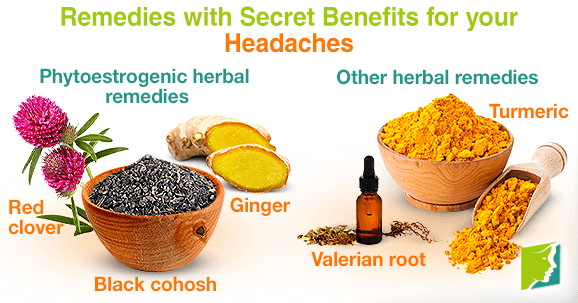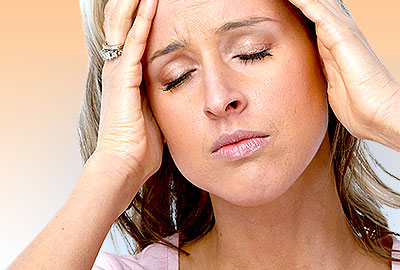Most people experience headaches at some point in their lives. Headaches can vary in intensity, ranging from mildly distracting pain to debilitating migraines, with nausea and temporary effects on vision. If they occur regularly, headaches can affect your work performance, social life, and well-being. Luckily, you can reduce the occurrence of headaches and migraines over time with certain herbal remedies. Below are some herbal remedies that can provide comfort and pain relief, as well as minimize the recurrence of headaches.

What Causes Headaches?
Headaches are a common affliction across ages and genders, but they are generally not a result of serious illness. A variety of things can cause headaches, hormonal imbalance being the primary one during menopause.
Hormonal imbalance
Many factors contribute to headaches in women, including family history and age. Women often notice a relationship between headaches and hormonal changes. Headaches are linked to hormonal imbalance in various stages of reproductive life, especially during the menstrual cycle, pregnancy, and menopause.
Other causes
Many things can cause headaches, including:
- Alcohol
- Red meat
- Lack of sleep
- Muscle tension
- Low blood sugar
- Dehydration
- Stress
Herbal Remedies for Hormonal Imbalance
There are two approaches for treating menopausal headaches: phytoestrogenic herbal remedies and hormone-regulating remedies.
Phytoestrogenic herbal remedies
Many women are concerned about the health risks of the synthetic hormones used in conventional hormone therapy, so they seek out natural alternatives. Phytoestrogens are compounds similar to hormones produced by the body, and they are unlikely to have adverse side effects. For example:
- Black Cohosh. Black cohosh can regulate headaches from estrogen deficiency over time, as the herb has an estrogenic function that helps restore low hormone levels. It is also an anti-inflammatory, pain-relieving herb, which is beneficial in treating headaches.
- Ginger. Ginger relieves pain in two ways: first, by blocking the formation of inflammatory compounds - such as prostaglandin and leukotriene - and second, by reducing existing inflammation. Ginger tea can be consumed to relieve headache pain and to provide comfort when you're not feeling your best.
Dong quai, chasteberry, and red clover are all herbs with estrogenic activity. Drinking infusions of these can reduce the frequency and intensity of headaches over time by encouraging hormone balance.
Hormone-regulating remedies
These supplements (such as Macafem) can be effective treatments for menopause symptoms and some of the safest and easiest ways to balance your hormones.
Other Herbal Remedies for Headaches
While these herbs do not affect hormone levels, they may help alleviate headaches.
Turmeric
In 2009, a study of turmeric in the Journal of Alternative and Complementary Medicine discovered it to be equally as effective as ibuprofen for relieving pain. Its anti-inflammatory properties come from the compound curcumin. The spicy nature of this herb - which is more commonly used in curry powder - means that consuming it in supplement form is probably the easiest way to enjoy its benefits for headaches.
Valerian Root
Valerian root is one of the most powerful existing herbal tranquilizers. It acts as a non-addictive sedative and has been found to relieve pain in aromatherapy (by adding the herb liberally to bathwater). Consumption of valerian root, either in tea or supplement form, can soothe the pain of headaches.
Menopausal headaches are usually caused by hormonal fluctuations, and these remedies can help to balance hormones, providing pain relief and soothing comfort. Remember, it is best to see a doctor if you experience alarming symptoms alongside your headaches or if your headaches are occurring with increasing frequency or intensity.
For further information on how to deal with headaches during menopause, click here.
Sources
- Better Health Chanel. (2015). Headaches. Retrieved January 14, 2016, from http://www.betterhealth.vic.gov.au/bhcv2/bhcarticles.nsf/pages/Headache
- Better Health Channel. (2013). Hormone headaches. Retrieved January 14, 2016, from http://www.betterhealth.vic.gov.au/bhcv2/bhcarticles.nsf/pages/Headache_and_hormones
- National Center for Complementary and Integrative Health. (2012). Turmeric. Retrieved January 14, 2016, from http://nccam.nih.gov/health/turmeric/ataglance.htm
- National Center for Complementary and Integrative Health. (2012). Valerian. Retrieved January 14, 2016, from http://nccam.nih.gov/health/valerian
- National Health Service UK. (2015). Headaches. Retrieved January 14, 2016, from http://www.nhs.uk/conditions/Headache/Pages/Introduction.aspx
- National Health Service UK. (2015). Hormone headaches. Retrieved January 14, 2016, from http://www.nhs.uk/Livewell/headaches/Pages/Hormonalheadaches.aspx
- National Institutes of Health. (2015). Ginger. Retrieved January 14, 2016, from http://www.nlm.nih.gov/medlineplus/druginfo/natural/961.html
- Office of Dietary Supplements. (2008). Black Cohosh. Retrieved January 14, 2016, from http://ods.od.nih.gov/factsheets/BlackCohosh-HealthProfessional/
- Women's Health Network. (2015). Herbs and Phytoestrogens. Retrieved January 14, 2016, from https://nwhn.org/herbs-and-phytoestrogens


